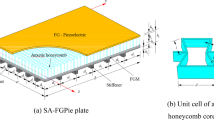Abstract
A new artificial boundary condition for time domain analysis of a structure-unlimited-foundation system was proposed. The boundary condition was based on the damping-solvent extraction method. The principle of the damping-solvent extraction method was described. An artificial boundary condition was then established by setting two spring-damper systems and one artificial damping limited region. A test example was developed to verify that the proposed boundary condition and model had high precision. Compared with the damping-solvent extraction method, this boundary condition is easier to be applied to finite element method (FEM)-based numerical calculations.
Similar content being viewed by others
References
Gu Y, Liu J B, Du Y X. 3D consistent viscous-spring artificial boundary and viscous-spring boundary element. Engineering Mechanics, 2007, 24(12): 31–38 (in chinese)
Lysmer J, Kuhlemeyer R L. Finite dynamic model for infinite media. J Engng Mech Div ASCE, 1969, 95(7): 759–877
Jiao Y Y, Zhang X L, Zhao J, Liu Q S. Viscous boundary of DDA for modeling stress wave propagation in jointed rock. International Journal of Rock Mechanics and Mining Sciences, 2007, 44(1): 1070–1076
Liu J B, Wang Z Y, Du X L. Three-dimensional visco-elastic artificial boundaries in time domain for wave motion problems. Engineering Mechanics, 2005, 22(6): 46–51 (in chinese)
Deeks A J, Randolph M F. Axisymmetric time-domain transmitting boundaries. Journal of Engineering Mechanics, 1994, 120(1): 25–42
Wang Z Y. Computational Theory of Dynamic Response of Large Structure-soil Systems and Its Application. Beijing: Tsinghua University; 2002: 24–28 (in chinese)
Zhang C H, Pan J W, Wang J T. Infiuence of seismic input mechanisms and radiation damping on arch dam response. Soil Dynamics and Earthquake Engineering, 2009, 29(9): 1282–1293
Liu J B, Gu Y, Du Y X. Consistent viscous-spring artificial boundaries and viscous-spring boundary elements. Chinese Journal of Geotechnical Engineering, 2006, 28(9): 1070–1075 (in chinese)
Clayton R, Engquist B. Absorbing boundary condition for waveequation migration. Geophysics, 1980, 45(1): 895–904
Clayton R, Engquist B. Absorbing boundary condition for acoustic and elastic wave equations. Bulletin of the Seismological Society of America, 1977, 67(1): 1529–1540
Higdon R L. Absorbing Boundary Condition for Acoustic and elastic waves in stratified media. Computers in Physics, 1992, 101(2): 386–418
Tsynkov S V. Artificial boundary conditions for the numerical simulation of unsteady acoustic waves. Journal of Computational Physics, 2003, 189(41–42): 626–650
Zhao C, Liu T. Non-reflecting artificial boundaries for modeling scalar wave propagation problems in two-dimensional half space. Computer Methods in Applied Mechanics and Engineering, 2002, 191(1): 4569–4585
Smith W A. Non-reflecting plane boundary for wave propagation problems. Journal of Computational Physics, 1973, 15(1): 492–503
GadiFibich. Semyon Tsynkov. High-order two-way artificial boundary conditions for nonlinear wave propagation with backscattering. Journal of Computational Physics, 2001, 171(1): 632–677
Song C, Wolf J P. The scaled boundary finite element method alias consistent infinitesimal finite element cell method for elastodynamics. Computer Methods in Applied Mechanics and Engineering, 1997, 147(3–4): 329–355
Liao Z P, Wong H L, Yang B, Yuan Y. A transmitting boundary for transient wave analysis. Scientia Sinica, 1984, 27(1): 1063–1073
Liao Z P, Liu J B. Numerical instabilities of a local transmitting boundary. Earthquake Engineering & Structural Dynamics, 1992, 21(1): 65–77
Author information
Authors and Affiliations
Corresponding author
Rights and permissions
About this article
Cite this article
Xu, Q., Chen, J., Li, J. et al. Study of an artificial boundary condition based on the damping-solvent extraction method. Front. Struct. Civ. Eng. 6, 281–287 (2012). https://doi.org/10.1007/s11709-012-0167-5
Received:
Accepted:
Published:
Issue Date:
DOI: https://doi.org/10.1007/s11709-012-0167-5




